Arnica Montana for Bruises, Sprains, and Wounds
Arnica montana is one of the very best herbal remedies for bruises, sprains, and strains. Here’s how to identify arnica in the wild and use it for herbal remedies.
You’ve probably seen this sunny, daisy-like flower growing on your homestead or in the surrounding landscape. It originated in the European Alps and is an immigrant to North America. It likes poor soil and waste places at higher elevations. The next time you see it, remember where it’s growing because it is one of the most beneficial herbs for healing inflammation, bruising, sudden pain, accident, and paralysis. It is easy to collect, easy to make medicine from and highly beneficial.
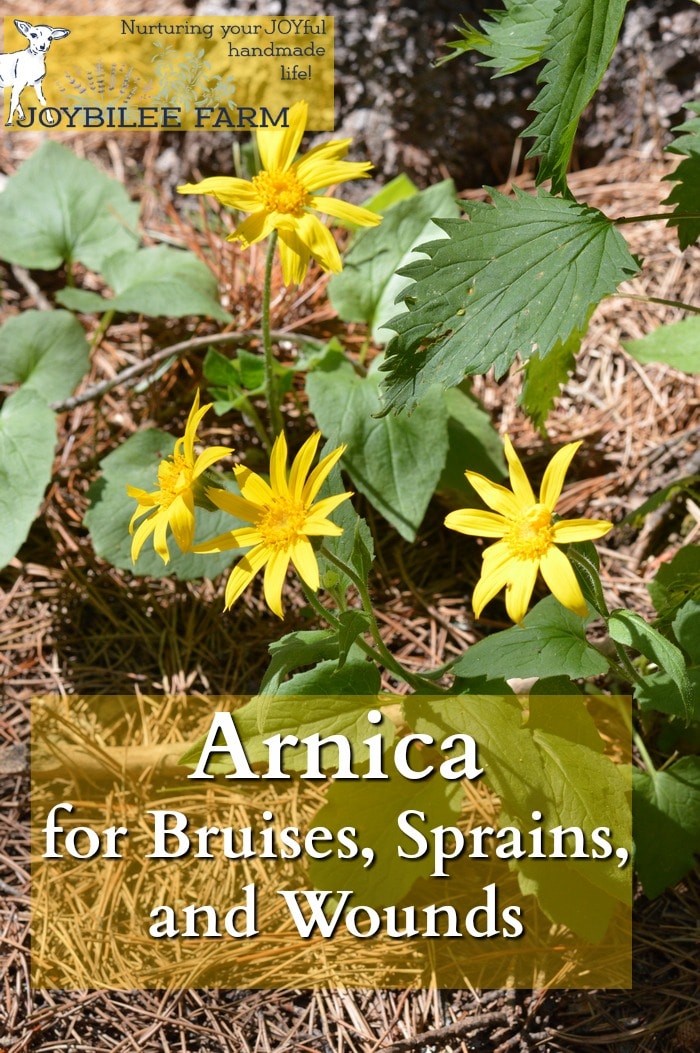
Mountain Sunflower, or Arnica montana, is a bright yellow, daisy-like flower that blooms in Spring on nutrient-poor hillsides, rocky places, and stony plains. The plant is toxic if ingested in large quantities but highly beneficial when used topically or as a highly diluted homeopathic tincture.
Arnica was found to have the same pain-relieving, anti-inflammatory effect as Ibuprofen (5%) when used in a gel at 50% concentration. This is the concentration that you would get if you infused the flowers in olive oil. There are reports in the literature of paralysis being healed with the use of arnica, as well. Definitely, an herb that is worth getting to know better. It has a pungent smell, its stem is slightly fuzzy, soft, hairy leaves. The name arnica comes from the Greek “arni” meaning lamb for this characteristic. The whole plant is used in herbal medicine, but since it is a perennial, most herbalists leave the plant in the ground and only harvest the flower heads.
It is one of the most famous remedies known to the herbalist for treatment of bruises, joint stiffness, wounds, swellings, and paralysis. – The Complete Herbal Handbook for Farm and Stable, J. Levy
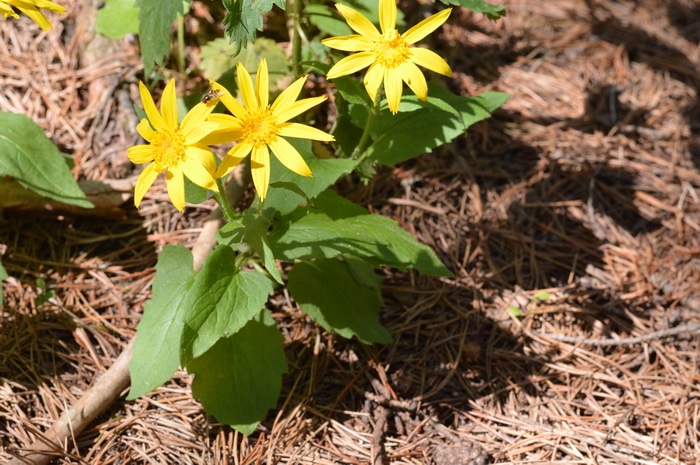
Heart-leafed arnica growing at the edge of a pine forest at 2700 feet.
Key features:
- Large, showy, yellow to orange daisy-like flower
- Hairy stem
- Opposite leaves
- Some varieties have hairy leaves
- Grows 12 to 24 inches tall
- Found in waste places and poor soil
When to collect arnica
Collect the fresh flower heads in Spring, before they wilt, usually from April to the end of May. If you are hunting for arnica you will find it blooming later, the higher you go. In hilly areas, it will bloom for weeks in May and June. While the whole plant can be used, taking the flowers and leaving the leaves will allow it to continue growing.
Tips for wildcrafting:
When harvesting in the wild always verify your plant ID in at least 3 independent sources before harvesting.
There are over 200 varieties of arnica that can be used for first aid and as anti-inflammatory salves. Use a good field guide to verify the growing range, and characteristics of the plants you have growing locally. While the daisy-like flower with opposite leaves is similar in all varieties of arnica, the leaf shape varies between varieties.
All varieties of arnica are toxic when eaten.
Some plants that you might confuse for Arnica:
Arrowleaf balsamroot or Mountain Sunflower (Balsamorhiza sagittata)
Then leaves are larger and the flowers larger and showier. The plants form large clumps in the dry interior, on mountain slopes. The plants stand 1 to 2 feet high with a single plant reaching 30 inches across.
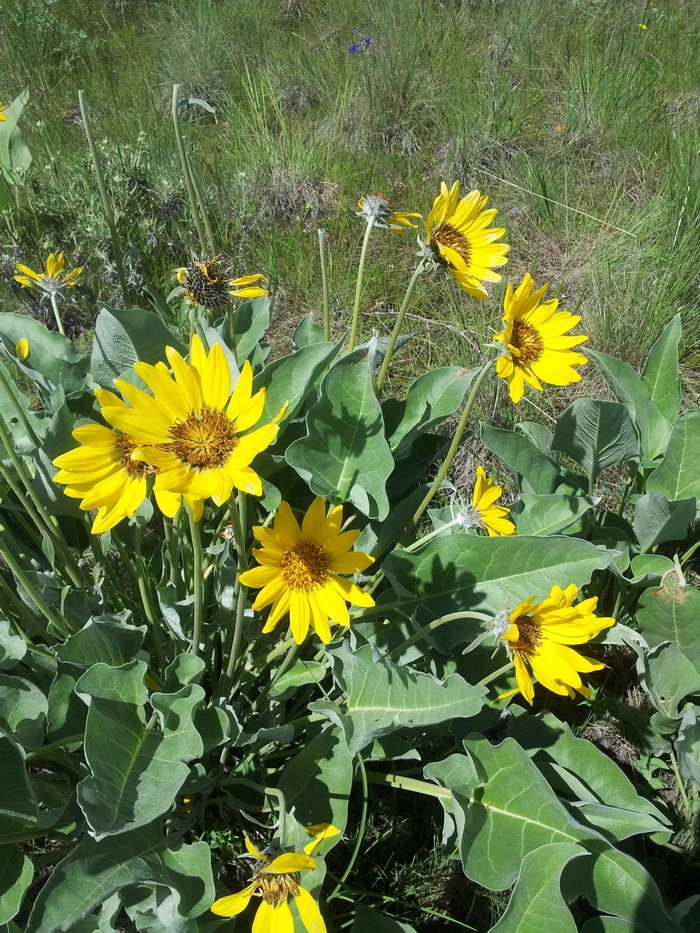
Mountain Sunflower, also known as Arrow Leaf Balsam Root. The flowers are larger and much showier than arnica.
This plant — Arrow-leaf balsamroot — was used by the First Nations for food. The seeds, like other sunflowers, are rich and oily. The roots were used much like Jerusalem artichoke as a starchy vegetable.
What to use arnica for?
Arnica can be used topically to treat many injuries as well as the inflammation and pain of arthritis. It is helpful for:
- Osteoarthritis
- Carpel Tunnel
- Bruising
- Sprains
- Strains
- Sudden pain
- Insect Stings
- Shock after an injury
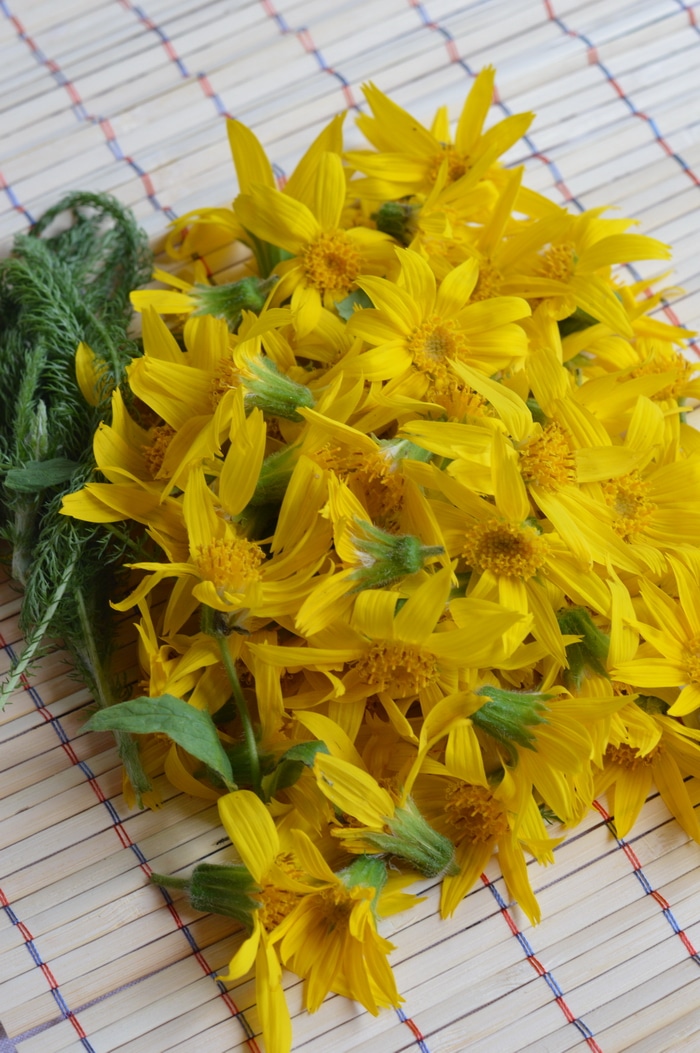
Making infused oil
You can steep the fresh flower heads in olive oil to make a massage cream for sore joints and bruises. To do this fill a wide-mouth quart jar with fresh flowers, and pour olive oil over the top. Remove air bubbles by sliding a knife along the side of the jar. Cap tightly and place in a warm place. Shake it daily and in 2 weeks, strain out the flowers and reserve the oil.
Making tincture
You can also make a tincture from the fresh flowers. The tincture is traditionally used as a treatment for inflamed nasal passages. To make a tincture, fill a wide mouth jar with fresh flowers, and pour 100 proof vodka over the flowers. Use a knife to remove air bubbles from the jar. Cap tightly and place in a warm place. Shake it daily and in 2 weeks, strain out the flowers and reserve the infused alcohol tincture. Use the tincture to make other medicines. By making a tincture you can preserve the quality of the fresh herb longer than if you simply dried the herb.
Arnica tincture can be used in place of arnica mother tincture in homeopathic medicine. Arnica tincture should be diluted significantly if you plan to use it internally, as a homeopathic remedy. Full strength arnica preparations should not be taken internally.
Making infusion
Arnica flowers can also be dried to be used as an infusion. The flower tops should be dried in the shade, on screens, and away from electric heat, until they are completely dry before storing in paper bags, well labelled. Dried herbs will keep for 2 years when dried this way. After 2 years you can put them in your garden and get a fresh batch of herbs. Arnica infusion is for topical use only.
To use place 1 large handful of dried flowers into 2 cups of boiled water. Allow to steep until the water is just warm. Squeeze out flowers and use them to massage the painful, swollen, or inflamed parts. Gypsies used this treatment on horses with sore, swollen legs.
Where to buy arnica
If you can’t find arnica growing close to you, dried arnica flowers can be found online. My favourite suppliers are Mountain Rose Herbs and Starwest Botanicals.
Or get seeds and grow your own arnica.
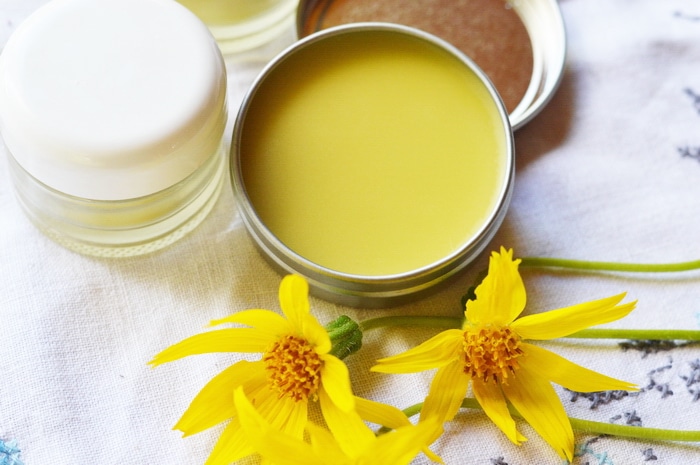
Grab my DIY arnica salve recipe here.
I have a FREE gift for you

Grab my free ebook and learn to make DIY herbal healing salves at home now, with 14 easy to follow recipes that use the herbs and wild plants growing close to home. Salve making is one of the easiest skills to learn in DIY Herbalism.



Hello there! I just noticed this spring that arnica leaves are quite fragrant and wondered if they could be infused in olive oil and the infusion used to make lotion or cream that would have that lovely scent? I have perused the internet and found only info about arnica flowers, your site is the only one that turned up any thing about the foliage when you said the whole herb could be used. It would make a lovely cream if it could have both the medicinal properties of the flower and the beautiful scent of the leaves! My concern of course was that the leaves didn’t have a toxic compound or be an allergen.
I would be so grateful if you could shed some light on this arnica leaf query of mine! Thank you so much! I love your site by the way and have been here several times for other queries and always found what I was looking for!
April